By Karen Morss Our good friend and P51-A Mustang owner, Jerry Gabe from Hollister, CA. did just that this year. Jerry has been going to the Air Races since 1964 but this would be the first time he took a racer. The trip to get there was especially challenging. In February 2002 Jerry purchased a ‘new’ zero-time replacement Allison engine from Dwight Thorn. He contracted with Dwight to overhaul the engine but illness prevented Dwight from completing the project. In November 2003, the parts in process were moved to the Hollister engine shop of Mike Barrow for completion. Changing the engine in a Mustang is a big job. It’s not like you just order up parts from Continental. Removing the Allison engine from the ‘A’ model Mustang (unlike the ‘D’ Rolls Royce) requires the engine be removed with the engine mount as a unit. In addition, all the hoses were replaced; the oil cooler, radiator, oil tank, ignition harness, carburetor, fuel nozzle, and all the engine accessories were removed for overhaul. You’ve heard the saying it takes a village to raise a child. Well, it takes a village to overhaul and install these big old engines. Jerry had lots of help from his friends. Jerry Beck was able to supply fresh engine mounts and additional specialized hardware. Dick Borg, a retired mechanical engineer worked with Jerry for many weeks, every day. Bud Wheeler, Cory Stendell and especially Dan Whitney, supplied engine support and technical help. Cleaning parts seemed never to end. The work progressed, some days slower than others. One day last January, (2005) my husband, Dave Morss, suggested, “Why don’t we race the plane at Reno. That way we’ll have a deadline and it’s a good way to break in the engine.” Jerry thought for a moment. “That should be enough time. Let’s do it.” Dave came home with a big grin and said I might want to work on a new t-shirt design because Polar Bear was going racing! By June 2005, Mike Barrow had completed the ‘new’ engine overhaul, with all the accessories installed. The oil system was upgraded to accept an additional oil cooler. Jerry didn’t have a test stand so the airplane would be used as the test stand. The initial installation and first engine run took place on August 20th, two weeks before Reno. But during the initial ground runs, they noticed oil fouling the plugs and intake system. They suspected a problem with the Supercharger. They took it off shipped it out for inspection on the 24th. Two days later they got the news. The Supercharger checked out fine. It wasn’t the source of the oil leak. In the meantime, Mike Barrow had been thinking on the problem and figured it out. He used modern rings on the Allison like those used on the racing Merlin engines. Turns out the pistons had to be modified to accommodate the new style rings. Dave called me from Hollister with the bad news. “I hope you didn’t order any shirts.” The team was despondent, so close, yet so far. Just when we thought there was no hope, Dan Martin and his crew saved the day. Dan and Jerry have been friends for more than fifteen years. Dan has raced his Mustang, Ridge Runner, for many years and knows the pitfalls of air racing. He’s dealt with everything from blown engines to broken fuel lines. But he always manages to get back in the race. He and his team showed up five o’clock Monday night (8/29). They pulled the engine and took it on their tug back to Barrow’s shop. In less than 48 hours, the pistons had been modified and the team was back in business. Dave called me from Hollister, “I hope you ordered enough shirts. We got a lot of people to thank.” Mike and his crew, Danny and his crew, Dick, Jerry and Dave got the engine back in the plane on Sunday, September 4th and readied her for ground runs. On Tuesday, after four hours of testing, they decided it was time to take her up for a flight. Everything proceeded smoothly until Dave put the gear down to land. The hydraulic system failed and he landed no flaps and no hydraulics. Dave called me on his cell. “I hope you didn’t place that order yet.” On Wednesday, they put the airplane on jacks with a hydraulic mule to check the gear. They blew the hydraulic system. Once again, Dan Martin came to the rescue with replacement parts to repair the hydraulic sequencing valves. They flew again later that day. On the 8th, they logged two more flights with a final test flight on Friday morning, the 9th. Everything checked out and it was decided to take the plane to Reno. Dave called me just before he left, “Order the shirts!” (For those of you who don’t know about www.Cafepress. com, I highly recommend them. Very fast turnaround and no set up charges!) Now we just had to pass Tech and qualify the airplane. It was not a given that we would make the field. Only 27 airplanes get to race in Unlimited. We had our fingers crossed that we would be one of them. Polar Bear was not a ‘tricked out’ racing airplane. It would depend on how many racers showed up, and how many broke during the course of the next few days. As it turned out, a lot of planes didn’t make it to the races this year including Precious Metal, September Fury, Critical Mass and Dago Red. During qualifying, Miss American, Strega and Vodoo were grounded. If ever there were a chance to make the field, this would be it. We had a great crew at Reno and they earned their keep. Michael Borg, Dick’s son, Jeremy Cain, Dave Griswold and Dan Whitney all pitched to help Jerry and Dick get the plane ready to race. Polar Bear passed tech inspection on Saturday with flying colors much to the delight of her crew chief, Dick Borg. On Sunday, Dave took her around the course during a practice session. Everything checked out and Dave said she took to the course like a natural. Monday morning was a beautiful sunny morning. It was time to go qualify. The team stood out on the tarmac hoping and praying and wishing and dreaming that all would go well for this challenge at Reno. Dave took off and in just a few moments they heard him call for the clock. The tower responded, “Race 25, you have the course”. Nothing sounds quite so good as a Mustang screaming around the pylons at Reno. They are so low and so close that you can feel the vibrations pass right through you. Dick had a timer and clocked Dave at 346 mph. would that be fast enough to make the field? As it turned out, we placed 22nd. Hey, Polar Bear was going to race, we didn’t care where we placed as long as we made the field. The team’s joy turned quickly to concern. As Dave taxied back to the ramp, they could see a trail of oil behind him. Once he shut down, it became obvious the plane was covered in oil. Back in the pits, they took off the cowling and determined that the new oil cooler had failed. A new one was ordered and Fedexed overnight. But a long day of cleaning had just begun. Oil was everywhere. Tuesday was spent installing the new oil cooler and trying to determine what made it fail and how to fix it, never a dull moment for a race crew at Reno. The plane was all back together in time for Wednesday’s practice session. Dave took off and we all held our breath. The plane looked great and sounded great as it flew around the course. He did five laps then pulled up and off and made a beautiful landing. Dry as a whistle, not a speck of oil anywhere. We were good to go. Thursday, he flew in the first heat race. Dave has more races than anyone in the history of Reno but I still say a prayer to the race angels and kiss him before each and every race. Today would be no different. Jerry was so nervous he couldn’t talk. I had my timer board to keep me busy. The rest of the crew was excited and thrilled just to be out on the ramp. Polar Bear finished second, behind Art Vance in Speedball Alice (Bless you, Art) and in front of Brant Seghetti in Sparky. A most respectable start in everyway, and the oil cooler worked. Dick and Jerry breathed a sigh of relief. One down, and I didn’t know how many to go. Dave raced two other airplanes at Reno this year, Stuart Fred’s L39 Tejas Pistolaros, in the Jet Class, and his Lancair Legacy in Sport Class so he was pretty busy all week. Thankfully, Jerry got me a golf cart so I could try to keep up with him. I laughed when I heard the announcer, Steve Stavrakakis, say that Dave must be sick of flying by the end of the day. He doesn’t know Dave. This is his favorite ten days of the year and not one thing about it tires him out. We were so excited by Friday’s pairings for Heat 2C, six Mustangs and a Tigercat. What a sight as the planes roared down the chute for the start of the race. As Dave came around pylon six on the start lap, he suddenly pulled up and off the course. We heard him announce over race control, ‘Race 25 pulling up with a gear door’. Now what? Dave circled overhead as Steve Hinton in the chase plane went by going straight up. We heard Steve tell Dave ‘doors are closed’ but by then it was too late to rejoin the field. Racing is nothing if not ups and downs. Dave made a beautiful landing and taxied back to a disappointed crew. Disappointment turned to determination as Dick Borg took charge to work the problem. They re-rigged the gear doors and switches. The last we saw Dick, he was hanging from the gear doors to test them. Dave had other races and briefings so he was off and running. The L39 had it’s own hydraulic problem that was being worked. We’ll at least the Legacy was running great except this year we had real competition from other four other Lancairs in Sport Class but those are other stories. We were back in business for Saturday’s Unlimited 3C heat race with a Wildcat, Tiger Cat, four Mustangs and a Yak. This is why 200,000 people come to Reno. Nowhere else in the world can you see these great old classic airplanes go at it, spinner to spinner competition. We took third behind Mike Brown in Big Bossman, the Tigercat and Speedball Alice, Art Vance’s Mustang. Best of all, no more gear door problems. On Sunday, the most glorious day at Reno, three Mustangs, a Yak and the Wildcat would do battle in the Unlimited Bronze Race. Two planes had bumped up to Silver so Dave has the pole for the start. Jimmy Leeward, in Cloud Dancer, had a mechanical on Saturday and bumps down to the Bronze race, starting last. I say a prayer as they come down the chute and the crowd cheers the start of the six-lap race. Dave has the lead as they come around home pylon and he leads the race for the next four laps. The crew is ecstatic but we can see Jimmy moving up the field on each lap. On lap five he catches then passes Dave and holds on to the lead to win. It didn’t matter. We were so proud of the team. They overcame one obstacle after another and never gave up. Two weeks before the race, we had a new engine that didn’t work. On Sunday, we finished second in the Bronze. Not bad for a first time Reno racer. It takes more than money to race at Reno. It takes a lot of good friends willing to put in hours and days of hard work, and the determination and courage to keep fighting no matter the odds. And it takes some pretty great flying by some of the most talented pilots in the world, my husband among them. The best of the best fly at Reno and the rest of us are grateful just to be part of the experience. Of course, Dave has already started counting down the days to next year’s race. What can I tell you? The man loves to race at Reno, 164 races and counting… Thank you, Race Angels. By the way, we ran out of t-shirts. History of P51-A N51Z Polar Bear, #43-6006, was built by North American at Inglewood, CA for the United States Army Air Corps. The aircraft was accepted by the AAC at Mines Field (now LAX) on April 3rd, 1943. On that same day, the aircraft left Los Angeles for Ladd Army Airfield in Alaska with stops at Long Beach, Hill Field, Gore Field and Edmonton, Canada, arriving at Ladd on May 1, 1943. February 18, 1944 with only 43 hours total time, the aircraft crashed near Summit, Alaska in heavy snow on a VFR flight plan. The pilot, Second Lt. Edward W. Getter was killed. The aircraft remained on that mountain, exposed to the weather and occasional visits by local hunters, who scribed their names on the engine valve covers. In the fall of 1977, more than thirty years after the crash, a very determined Waldon “Moon” Spillers, with the help of two friends, removed the wreckage from the side of the mountain, too steep for helicopters. The aircraft remains were shipped to Ohio, where Waldon rebuilt the aircraft. Working on it almost everyday, Polar Bear flew again on July 3, 1985. In the spring of 1995, with just over 100 hours flying time since rebuild, the aircraft was sold to its current owner, Jerry Gabe, who lives in Hollister, CA. A twelve-cylinder Allison V1710 engine and Curtis Electric three-blade propeller power the aircraft. |
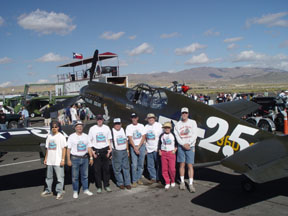
| Polar Bear Crew Jeremy Cain, Dan Whitney, Michael Borg, Jerry Gabe, Dave Griswold, Dick Borg, Karen & Dave Morss |
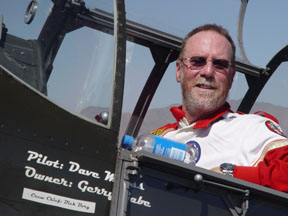
| Polar Bear Pilot - Dave Morss |
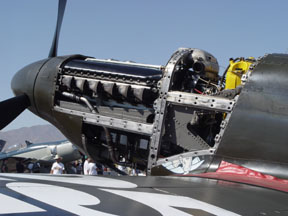
| Polar Bear's Allison engine |
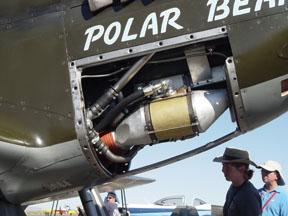
| New Oil Cooler Installed |
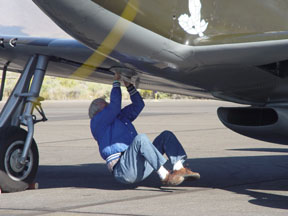
| Crew Chief, Dick Borg, checks gear doors |
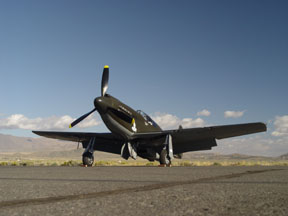
| Ready to race |
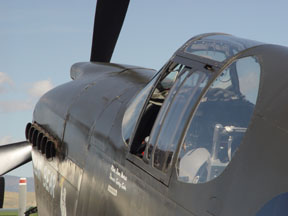
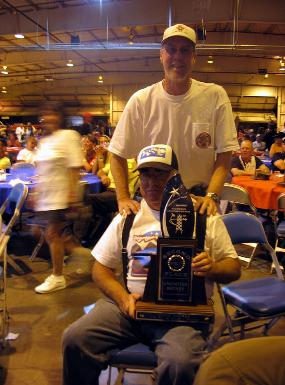
| Jerry and Dave at Awards Banquet 2nd place Bronze |
| Special Thanks to Naomi West and Dan Whitney for their spectacular photos. |


| PART TWO POLAR BEAR RACES AGAIN! |
| Racing |
